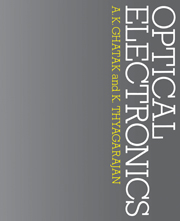Book contents
- Frontmatter
- Contents
- Preface
- 1 Maxwell's equations and propagation of electromagnetic waves
- 2 Reflection and refraction of electromagnetic waves
- 3 Wave propagation in anisotropic media
- 4 Fraunhofer diffraction
- 5 Fresnel diffraction
- 6 Spatial frequency filtering
- 7 Holography
- 8 Lasers: I
- 9 Lasers: II
- 10 Some laser systems
- 11 Electromagnetic analysis of the simplest optical waveguide
- 12 Leaky modes in optical waveguides
- 13 Optical fibre waveguides
- 14 Integrated optics
- 15 The electrooptic effect
- 16 The strain optic tensor
- 17 Acoustooptlc effect: Raman–Nath diffraction
- 18 Acoustooptic effect: Bragg diffraction
- 19 Acoustooptic devices
- 20 Nonlinear optics
- Appendices
- References and suggested reading
- Index
19 - Acoustooptic devices
Published online by Cambridge University Press: 05 June 2012
- Frontmatter
- Contents
- Preface
- 1 Maxwell's equations and propagation of electromagnetic waves
- 2 Reflection and refraction of electromagnetic waves
- 3 Wave propagation in anisotropic media
- 4 Fraunhofer diffraction
- 5 Fresnel diffraction
- 6 Spatial frequency filtering
- 7 Holography
- 8 Lasers: I
- 9 Lasers: II
- 10 Some laser systems
- 11 Electromagnetic analysis of the simplest optical waveguide
- 12 Leaky modes in optical waveguides
- 13 Optical fibre waveguides
- 14 Integrated optics
- 15 The electrooptic effect
- 16 The strain optic tensor
- 17 Acoustooptlc effect: Raman–Nath diffraction
- 18 Acoustooptic effect: Bragg diffraction
- 19 Acoustooptic devices
- 20 Nonlinear optics
- Appendices
- References and suggested reading
- Index
Summary
Introduction
In the previous two chapters we have discussed the basic principle behind acoustooptic interaction. In this chapter we will discuss some important acoustooptic devices. We have seen in the previous two chapters that the intensity of the diffracted light depends on the acoustic power. Thus by changing the acoustic power one can correspondingly modulate the intensity of the diffracted light beam. This is the basic principle behind an acoustooptic modulator. We have also seen that the angle of diffraction depends on the acoustic frequency. Thus if we have an acoustic beam whose frequency is changed, the corresponding diffracted light beam will appear along different directions. This is the basic principle behind the acoustooptic deflector. If the acoustic transducer is given an input signal whose frequency increases with time, then the corresponding diffracted light beam will scan along different directions leading to an acoustooptic scanner. If on the other hand the acoustic transducer is fed simultaneously with a signal containing different frequencies then corresponding to each frequency, the diffracted light appears along different directions and this principle is used in the acoustooptic spectrum analyser. In this chapter we shall discuss the operation of a Raman–Nath modulator, a Bragg modulator, a deflector and a spectrum analyser.
Raman–Nath acoustooptic modulator
Fig. 19.1 shows an acoustooptic modulator based on Raman–Nath diffraction.
- Type
- Chapter
- Information
- Optical Electronics , pp. 546 - 563Publisher: Cambridge University PressPrint publication year: 1989



